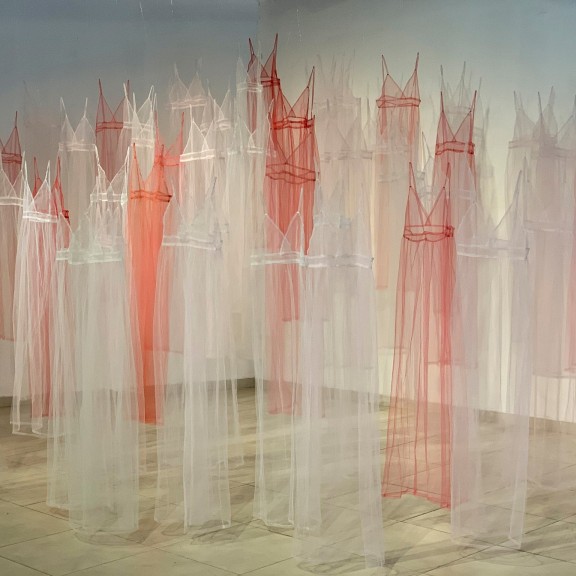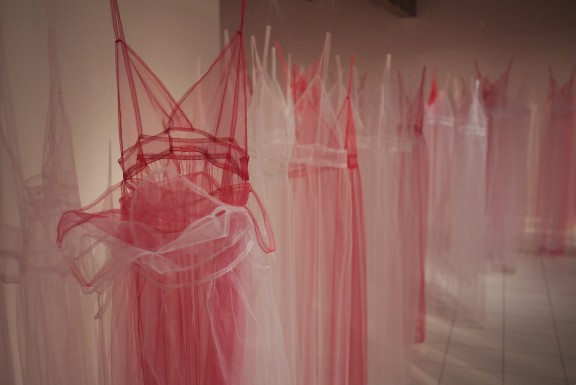Sleep Disorder
Camisones de tul
Medidas variables
Restitution of the dream
A garment defines sleep. A clothed sleep. The garment that defines sleep is vulnerable, volatile, intimate. It corresponds with a supposed domesticity and the hour in which the body rests to recover from whatever has happened. The restfulness of safe sleep.
A set of these garments is assembled by the artist as an installation. In different variants (be it filling a space with said garments or piling them up, as if they were a changing skin), these garments have been chosen by the artist for a cause only known to her. If she were to reveal the code, we would only have the voluptuousness of the body that abandoned the garment exhibited.
Casarino has been working with clothes for a while now. She always relates them to a gender perspective. She delivers, thus, a reflection. The garments only mobilize a turn of events, as if her works were a story. In that story, a narrative line develops in one direction, and another narrative line finds the first one; therein lies the turn of events.
We know that, in this installation, one of the narrative lines is completely visible: the garments. They speak to us of an intimate moment, a domestic life, behind closed doors. They also speak to us from the material with which they were tailored, tulle, as well as from their semantic ability regarding their interplay as veils (covering and revealing). Almost always associated, in our culture, to rites of passage, such as marriage or the fifteenth birthday of our young women, this material ―transformed into a stereotypical characteristic imposed in several cultural manifestations― is also providing us information. Its volatility and the game of transparencies proposed by tulle here does not only seem to approach that which is intimate, it is also an indication of that cliché: femininity as something volatile, as a subjectivity firmly adhered to social demands. That which is volatile: something easily dissipated. A transparent fabric that hangs from invisible threads, maybe hardly resistant, that affirms and reproduces a cliché about the feminine, its wrapping.
But, which is that narrative line that will not allow the first one to develop as it has been developing?
Therein lies the key revealed by the artist: traffic. A word with multiple meanings. One of them pertaining to people as objects of transaction.
Human trafficking, ever present in the histories of peripheral countries, supposes an economic movement surpassed only in its illegality by drug and arms trafficking. One of human trafficking's main goals is sexual exploitation. Generally, women, trafficked individuals are deceived by others (many times by people in their own social circles) offering them well paid jobs in some other country. Once at the airport they are stripped of their passports and taken to the real working site, from which leaving will be very difficult.
These garments, associated with sleep, with peaceful rest in that first narrative line, encounter an atrocious destiny. Some other narrative line preventing the first from developing as it was. Human trafficking barges into intimacy, making that which is vulnerable even more vulnerable: sleep is no longer safe and it may turn into a nightmare.
Perhaps, Claudia's dream is restoring that divested quietness, returning dreams to sleep. Returning, finally, the quietness of domestic sleep in the presence of a besieged intimacy and body, turned into trafficked merchandise.
Lia Colombino




